Final-Stage Magmatic Record of Paleo-Asian Oceanic Subduction? Insights from Late Permian to Early Triassic Intrusive Rocks in the Yanbian Area, Easternmost Central Asian Orogenic Belt
Abstract
1. Introduction
2. Geological Background and Sample Descriptions
3. Analytical Methods
3.1. Zircon U–Pb Dating and Situ Hf Isotope Analysis
3.2. Whole-Rock Elemental Analysis
3.3. Whole-Rock Sr–Nd Isotope Analysis
4. Analytical Results
4.1. LA–ICPMS Zircon U–Pb Ages
4.1.1. Quartz Diorite (Sample FN25)
4.1.2. Hornblende Gabbro (Sample B4117)
4.2. Zircon Hf Isotopic Compositions
4.3. Major and Trace Elements
4.4. Sr–Nd Isotopic Analyses
5. Discussion
5.1. Petrogenesis
5.1.1. Petrogenesis of Late Permian Diorites
5.1.2. Petrogenesis of the Early Triassic Mafic Rocks
5.1.3. Petrogenesis of Triassic Granitic Rocks
5.2. Tectonic Setting of the Early Triassic Bimodal Igneous Rocks
5.3. Late Carboniferous to Triassic Magmatic Events in the Yanbian Area
5.3.1. The Late Carboniferous–Early Permian Magmatic Event in Yanbian Area
5.3.2. The Middle–Late Permian Magmatic Event in the Yanbian Area
5.3.3. The Early Triassic Magmatic Event in the Yanbian Area
5.3.4. The Middle Triassic Magmatic Events in Yanbian Area
5.3.5. The Late Triassic Magmatic Event in Yanbian Area
5.4. Tectonic Implications
5.4.1. Eastward Extent of the Solonker–Xar Moron–Changchun Suture
5.4.2. The Final Scissor-Like Closure Model of the Paleo-Asian Ocean in Easternmost Central Asian Ocean Belt
6. Conclusions
- LA–ICP–MS zircon U–Pb dating indicates that mafic and granitic intrusions in the Helong area of NE China formed in Late Permian (~257 Ma) and Early Triassic (~251 Ma) times.
- The Late Permian diorites show the petrologic and geochemical characteristics of arc type igneous rocks enriched in LILE and depleted in HFSE. The geochemical and isotopic features suggest that the primary magma for Late Permian quartz diorite should be derived from partial melting of a juvenile lower continental crust.
- The Early Triassic intrusions including granites and gabbros represent a bimodal igneous rock association. The granites have an affinity to the shoshonitic rocks with enrichment of LILE sand LREEs and depletion of TNT (Ta, Nb, and Ti). The Sr–Nd isotopic and zircon Hf isotopic data show that the primary magma of gabbros could be derived from partial melting of a juvenile lithospheric depleted mantle source whereas the primary magma of the Early Triassic granites could be mainly derived from partial melting of juvenile lower crust, with minor contributions of the crustal material of the NCC.
- The Early Triassic intrusions formed in an extensional setting due to the breakoff of the previously subducted slab.
Author Contributions
Funding
Acknowledgments
Conflicts of Interest
References
- Sengör, A.M.C.; Natal’In, B.A.; Burtman, V.S. Evolution of the Altaid Tectonic Collage and Palaeozoic Crustal. Growth in Eurasia. Nature 1993, 364, 299–307. [Google Scholar] [CrossRef]
- Jahn, B.M.; Griffin, W.L.; Windley, B. Continental growth in the Phanerozoic: Evidence from Central Asia. Tectonophysics 2000, 328, vii–x. [Google Scholar] [CrossRef]
- Xiao, W.J.; Windley, B.F.; Hao, J.; Zhai, M.G. Accretion leading to collision and the Permian Solonker suture, Inner Mongolia, China: Termination of the central Asian orogenic belt. Tectonics 2003, 22, 1–20. [Google Scholar] [CrossRef]
- Liu, Y.J.; Li, W.M.; Feng, Z.Q.; Wen, Q.B.; Neubauer, F.; Liang, C.Y. A Review of the Paleozoic Tectonics in the Eastern Part of Central Asian Orogenic Belt. Gondwana Res. 2017, 43, 123–148. [Google Scholar] [CrossRef]
- Wu, F.Y.; Sun, D.Y.; Ge, W.C.; Zhang, Y.B.; Grant, M.L.; Wilde, S.A.; Jahn, M. Geochronology of the Phanerozoic Granitoids in Northeastern China. J. Asian Earth Sci. 2011, 41, 1–30. [Google Scholar] [CrossRef]
- Zhou, J.B.; Han, J.; Wilde, S.A.; Guo, X.D.; Zeng, W.S.; Cao, J.L. A Primary Study of the Jilin–Heilongjiang High–pressure Metamorphic Belt: Evidence and Tectonic Implications. Acta Petrol. Sin. 2013, 29, 386–398, (in Chinese with English abstract). [Google Scholar]
- Zhang, C.; Liu, Y.J.; Zhang, Z.L.; Cui, F.H.; Zhang, C.; Guan, Q.B.; Li, Y. Deformation and Geochronological Characteristics of Gudonghe Ductile Shear Zone in Yanbian Area. Earth Sci. 2019, 46, 3253–3264, (in Chinese with English abstract). [Google Scholar]
- Miao, L.C.; Fan, W.M.; Liu, D.Y.; Zhang, F.Q.; Shi, Y.R.; Guo, F. Geochronology and geochemistry of the Hegenshan ophiolitic complex: Implications for late-stage tectonic evolution of the Inner Mongolia-Daxinganling Orogenic Belt, China. J. Asian Earth Sci. 2008, 32, 348–370. [Google Scholar] [CrossRef]
- Xu, B.; Zhao, P.; Bao, Q.Z.; Zhou, Y.H.; Wang, Y.Y.; Luo, Z.W. Preliminary study on the pre-Mesozoic tectonic unit division of the Xing-Meng Orogenic Belt (XMOB). Acta Petrol. Sin. 2014, 30, 1841–1857, (In Chinese with English abstract). [Google Scholar]
- Xiao, W.J.; Windley, B.F.; Sun, S.; Li, J.; Huang, B.C.; Han, C.M.; Yuan, C.; Sun, M.; Chen, H.L. A tale of amalgamation of three Permo-Triassic collage systems in Central Asia: Oroclines, sutures, and terminal accretion. Annu. Rev. Earth Planet. Sci. 2015, 43, 477–507. [Google Scholar] [CrossRef]
- Wilde, S.A.; Zhou, J.B. The late Paleozoic to Mesozoic evolution of the eastern margin of the Central Asian Orogenic Belt in China. J. Asian Earth Sci. 2015, 113, 909–921. [Google Scholar] [CrossRef]
- Ma, X.H.; Chen, C.J.; Zhao, J.X.; Qiao, S.L.; Zhou, Z.H. Late Permian intermediate and felsic intrusions in the eastern Central Asian Orogenic Belt: Final–stage magmatic record of Paleo–Asian Oceanic subduction? Lithos 2019, 326, 265–278. [Google Scholar] [CrossRef]
- Feng, Z.Q.; Liu, Y.J.; Li, L.; Jin, W.; Jiang, L.W.; Li, W.M.; Zhao, Y.L. Geochemical and geochronological constraints on the tectonic setting of the Xinlin ophiolite, northern Great Xing’an Range, NE China. Lithos 2019, 326, 213–229. [Google Scholar] [CrossRef]
- Jian, P.; Liu, D.Y.; Kröner, A.; Windley, B.F.; Shi, Y.R.; Zhang, W.; Zhang, F.Q.; Miao, L.C.; Zhang, L.Q.; Tomurhuu, D. Evolution of a Permian intraoceanic arc–trench system in the Solonker suture zone, Central Asian Orogenic Belt, China and Mongolia. Lithos 2010, 118, 169–190. [Google Scholar] [CrossRef]
- Du, Q.X.; Han, Z.Z.; Shen, X.L.; Han, C.; Song, Z.G.; Gao, L.H.; Han, M.; Zhong, W.J. Geochronology and Geochemistry of Permo–Triassic Sandstones in Eastern Jilin Province (NE China): Implications for Final Closure of the Paleo-Asian Ocean. Geosci. Front. 2019, 10, 683–709. [Google Scholar] [CrossRef]
- Tang, J.; Li, A.P.; Xu, W.L. Geochronology and geochemistry of late Carboniferous–Middle Jurassic magmatism in the Helong area, NE China: Implications for the tectonic transition from the Paleo-Asian oceanic to circum-Pacific regime. Geol. J. 2020, 55, 1808–1825. [Google Scholar] [CrossRef]
- Xu, B.; Wang, X.C.; Wang, T.; Jahn, B.M.; Kroner, A. Preface. Lithos 2016, 261, 1–4. [Google Scholar] [CrossRef]
- Sun, Y.W.; Li, M.S.; Ge, W.C.; Zhang, Y.L.; Zhang, D.J. Eastward termination of the Solonker–Xar Moron River Suture determined by detrital zircon U–Pb isotopic dating and Permian floristics. J. Asian Earth Sci. 2013, 75, 243–250. [Google Scholar] [CrossRef]
- Tang, K.D.; Shao, J.A.; Li, J.C.; Kang, Z. Nature of the Yanbian Suture Zone and Structure of Northeast Asia. Geol. Bull. China 2004, 23, 885–891, (in Chinese with English abstract). [Google Scholar]
- Song, Z.G.; Han, Z.Z.; Gao, L.H.; Gao, L.H.; Geng, H.Y.; Li, X.P.; Meng, F.X.; Han, M.; Zhong, W.J.; Li, J.J.; et al. Permo–Triassic evolution of the southern margin of the Central Asian Orogenic Belt revisited: Insights from Late Permian igneous suite in the Daheishan Horst, NE China. Gondwana Res. 2018, 56, 23–50. [Google Scholar] [CrossRef]
- Jia, D.C.; Hu, R.Z.; Lu, Y.; Qiu, X.L. Collision belt between the Khanka block and the North China block in the Yanbian Region, Northeast China. J. Asian Earth Sci. 2004, 23, 211–219. [Google Scholar]
- Cao, H.H.; Xu, W.L.; Pei, F.P.; Zhang, X.Z. Permian tectonic evolution in southwestern Khanka Massif: Evidence from zircon U-Pb chronology, Hf isotope and geochemistry of gabbro and diorite. Acta Geol. Sin. 2011, 85, 1390–1402. [Google Scholar]
- Ren, Y.S.; Chen, C.; Zou, X.T.; Zhao, H.L.; Hao, Y.J.; Hou, H.N.; Hu, Z.C.; Jiang, G.H. The age, geological setting, and types of gold deposits in the Yanbian and adjacent areas, NE China. Ore Geol. Rev. 2016, 73, 284–297. [Google Scholar] [CrossRef]
- Ma, X.H.; Zhu, W.P.; Zhou, Z.H.; Qiao, S.L. Transformation from Paleo–Asian Ocean Closure to Paleo–Pacificsubduction: New Constraints from Granitoids in the Eastern Jilin–Heilongjiang Belt, NE China. J. Asian Earth Sci. 2017, 144, 261–286. [Google Scholar] [CrossRef]
- Guan, Q.B.; Liu, Z.H.; Liu, Y.J.; Li, S.Z.; Wang, S.J.; Chen, Z.X.; Zhang, C. A Tectonic Transition from Closure of the Paleo-Asian Ocean to Subduction of the Paleo-Pacific Plate: Insights from Early Mesozoic Igneous Rocks in Eastern Jilin Province, NE China. Gondwana Res. 2020, in press. [Google Scholar] [CrossRef]
- Zhang, Y.; Sun, J.G.; Xing, S.W.; Zhao, K.Q.; Ma, Y.B. Geochronology and metallogenesis of porphyry Mo deposits in east-central Jilin province, China: Constraints from molybdenite Re–Os isotope systematics. Ore Geol. Rev. 2015, 71, 363–372. [Google Scholar] [CrossRef]
- Wu, F.Y.; Zhao, G.C.; Sun, D.Y.; Wilde, S.A.; Yang, J.H. The Hulan Group: Its Role in the Evolution of the Central Asian Orogenic Belt of Ne China. J. Asian Earth Sci. 2007, 30, 542–556. [Google Scholar] [CrossRef]
- Zhou, Z.B.; Pei, F.P.; Wang, Z.W.; Cao, H.H.; Xu, W.L.; Wang, Z.J.; Zhang, Y. Using detrital zircons from late Permian to Triassic sedimentary rocks in the south–eastern Central Asian Orogenic Belt (NE China) to constrain the timing of the final closure of the Paleo–Asian Ocean. J. Asian Earth Sci. 2017, 144, 82–109. [Google Scholar] [CrossRef]
- Shen, X.L.; Du, Q.X.; Han, Z.Z.; Song, Z.G.; Han, C.; Zhong, W.J.; Ren, X. Constraints of zircon U–Pb–Hf isotopes from Late Permian–Middle Triassic flora–bearing strata in the Yanbian area (NE China) on a scissor–like closure model of the Paleo–Asian Ocean. J. Asian Earth Sci. 2019, 183, 103964. [Google Scholar] [CrossRef]
- Zhang, Y.B.; Wu, F.Y.; Wilde, S.A.; Zhai, M.G.; Lu, X.P.; Sun, D.Y. Zircon U–Pb ages and tectonic implications of ‘Early Paleozoic’ granitoids at Yanbian, Jilin Province, Northeast China. Isl. Arc 2004, 13, 484–505. [Google Scholar] [CrossRef]
- Cao, H.H.; Xu, W.L.; Pei, F.P.; Wang, Z.W.; Wang, F.; Wang, Z.J. Zircon U–Pb geochronology and petrogenesis of the Late PaleozoicEarly Mesozoic intrusive rocks in the eastern segment of the northern margin of the North China Block. Lithos 2013, 170–171, 191–207. [Google Scholar] [CrossRef]
- Yang, D.G.; Sun, D.Y.; Gou, J.; Hou, X.G. U–Pb ages of zircons from Mesozoic intrusive rocks in the Yanbian area, Jilin Province, NE China: Transition of the Paleo–Asian oceanic regime to the circum–Pacific tectonic regime. J. Asian Earth Sci. 2017, 143, 171–190. [Google Scholar] [CrossRef]
- Wang, Z.J.; Xu, W.L.; Pei, F.P.; Wang, Z.W.; Li, Y.; Cao, H.H. Geochronology and geochemistry of middle Permian–Middle Triassic intrusive rocks from central–eastern Jilin Province, NE China: Constraints on the tectonic evolution of the eastern segment of the Paleo–Asian Ocean. Lithos 2015, 238, 13–25. [Google Scholar] [CrossRef]
- Guan, Q.B.; Li, S.C.; Zhang, C.; Shi, Y.; Li, P.C. Zircon U–Pb Dating, Geochemistry and Geological Significance of the I–type Granites in Helong Area, the Eastern Section of the Southern Margin of Xing–Meng Orogenic Belt. Acta Petrol. Sin. 2016, 32, 2690–2706, (in Chinese with English abstract). [Google Scholar]
- Yang, H.; Ge, W.C.; Dong, Y.; Bi, J.H.; Ji, Z.; He, Y.; Jing, Y.; Xu, W.L. Permian subduction of the Paleo–Pacific (Panthalassic) oceanic lithosphere beneath the Jiamusi Block: Geochronological and geochemical evidence from the Luobei mafic intrusions in Northeast China. Lithos 2019, 332, 207–225. [Google Scholar] [CrossRef]
- JBGMR (Jilin Bureau of Geology and Mineral Resources). Regional Geology of Jilin Province; Geological Publishing House: Beijing, China, 1988; pp. 1–698, (In Chinese with English abstract).
- Zhang, C. The Mesozoic Tectonic Evolution of Yanbian Area in the Eastern Segment of Northern Margin of the North China Block; Jilin University: Changchun, China, 2014; pp. 1–150, (In Chinese with English abstract). [Google Scholar]
- Zhang, C.; Guo, W.; Xu, Z.Y.; Liu, Z.H.; Liu, Y.J.; Lei, C.C. Study on geochronology, petrogenesis and tectonic implications of monzogranite from the Yanbian area, eastern Jilin Province. Acta Petrol. Sin. 2014, 30, 512–526, (In Chinese with English abstract). [Google Scholar]
- Li, H.K.; Geng, J.Z.; Hao, S.; Zhang, Y.Q.; Li, H.M. Study on the using LA-MC-ICPMS to date the U-Pb isotopic age of zircons. Bull. Miner. Petrol. Geochem. 2009, 77, 600–601, (In Chinese with English abstract). [Google Scholar]
- Andersen, T. Correction of common lead in U–Pb analyses that do not report 204Pb. Chem. Geol. 2002, 192, 59–79. [Google Scholar] [CrossRef]
- Geng, J.Z.; Li, H.K.; Zhang, J.; Zhou, H.Y.; Li, H.M. Zircon Hf isotope analysis by means of LA-MC-ICP-MS. Geol. Bull. China 2011, 30, 1508–1513. [Google Scholar]
- Li, X.H. Geochemistry of the Longsheng Ophiolite from the southern margin of Yangtze Craton, SE China. Geochem. J. 1997, 31, 323–338. [Google Scholar] [CrossRef]
- Jia, L.Q.; Mo, X.X.; Dong, G.W.; Xu, W.Y.; Wang, L.; Guo, X.D.; Wang, Z.H.; Wei, S.G. Genesis of lamprophyres from Machangqing, western Yunnan: Constraints from geochemistry, geochronology and Sr-Nd-Pb-Hf isotopes. Acta Petrol. Sin. 2013, 29, 1247–1260, (in Chinese with English abstract). [Google Scholar]
- Shi, Y.; Liu, Z.H.; Xu, Z.Y.; Wang, X.A.; Zhang, C.; Liu, W.Z.; Chen, X. Isotopic chronology and geochemistry of the Hercynian Yongxin granitoid in Longjing, Jilin Province. Geol. Resour. 2013, 22, 6–13, (In Chinese with English abstract). [Google Scholar]
- Yang, J.H.; Wu, F.Y.; Shao, J.A.; Wilde, S.A.; Xie, L.W.; Liu, X.M. Constraints on the timing of uplift of the Yanshan Fold and Thrust Belt, North China. Earth Planet. Sci. Lett. 2006, 246, 336–352. [Google Scholar] [CrossRef]
- Irvine, T.H.; Baragar, W.R.A. A guide to the chemical classification of the common volcanic rocks. Can. J. Earth Sci. 1971, 8, 523–548. [Google Scholar] [CrossRef]
- Peccerillo, A.; Taylor, A.R. Geochemistry of Eocene calc-alkaline volcanic rocks from the Kastamonu area, Northern Turkey. Contrib. Mineral. Petrol. 1976, 58, 63–81. [Google Scholar] [CrossRef]
- Jia, X.H.; Wang, X.D.; Yang, W.Q.; Niu, Z.J. An Overview of Studies on shoshonitic rocks. Geol. Rev. 2017, 63, 1587–1600, (In Chinese with English abstract). [Google Scholar]
- Müller, D.; Groves, D.I. Direct and indirect associations between potassic igneous rocks shoshonites and gold-copper deposits. Ore Geol. Rev. 1993, 8, 383–406. [Google Scholar] [CrossRef]
- Boynton, W.V. Geochemistry of the Rare Earth Elements Meteorite Studies. In Rare Earth Element Geochemistry; Henderson, P., Ed.; Elsevier Science Publishers: Amsterdam, The Netherlands, 1984; pp. 63–114. [Google Scholar]
- Sun, S.S.; McDonough, W.F. Chemical and Isotopic Systematics of Oceanic Basalts: Implications for Mantle Composition and Processes. In Magmatism in Ocean Basins; Saunders, A.D., Norry, M.J., Eds.; Geological Society Special Publications: London UK, 1989; Volume 42, pp. 313–345. [Google Scholar]
- Jahn, B.M.; Wu, F.Y.; Chen, B. Massive granitoid generation in Central Asia: Nd isotope evidence and implication for continental growth in the Phanerozoic. Episodes 2000, 23, 82–92. [Google Scholar] [CrossRef]
- Wu, F.Y.; Jahn, B.M.; Wilde, S.A.; Sun, D.Y. Phanerozoic continental crustal growth: U-Pb and Sr-Nd isotopic evidence from the granites in northeastern China. Tectonophysics 2000, 328, 89–113. [Google Scholar] [CrossRef]
- Patiño Douce, A.E. Experimental generation of hybrid silicic melts by reaction of high-Al basalt with metamorphic rocks. J. Geophys. Res. Atmos. 1995, 1001, 15623–15640. [Google Scholar] [CrossRef]
- Patiño Douce, A.E. Generation of metaluminous A-type granites by low-pressure melting of calc-alkaline granitoids. Geology 1997, 25, 743–746. [Google Scholar] [CrossRef]
- Rudnick, R.L.; Gao, S. The Composition of the Continental Crust. In the Crust; Rudnick, R.L., Ed.; Elsevier-Pergamon: Oxford, UK, 2003; pp. 1–64. [Google Scholar]
- Frey, F.A.; Prinz, M. Ultramafic inclusions from San Carlos, Arizona: Petrologic and geochemical data bearing on their petrogenesis. Earth Planet. Sci. Lett. 1978, 38, 129–176. [Google Scholar] [CrossRef]
- Guo, F.; Li, H.X.; Fan, W.M.; Li, J.Y.; Zhao, L.; Huang, M.W. Variable sediment flux in generation of Permain subduction related mafic intrusions from the Yanbian region, NE China. Lithos 2015, 261, 195–215. [Google Scholar] [CrossRef]
- Wilson, M. Igneous Petrogenesis; Unwin Hyman Press: London, UK, 1989; pp. 1–466. [Google Scholar]
- Pearce, J.A. Role of the Sub-Continental Lithosphere Inmagma Genesis at Active Continental Margins. In Continental Basalts and Mantle Xenoliths; Hawkesworth, C.J., Norry, M.J., Eds.; Birkhauser: Nantwich, Switzerland, 1983; pp. 230–249. [Google Scholar]
- Puchtel, I.S.; Hofmann, A.W.; Mezger, K.; Jochum, K.P.; Shchipansky, A.A.; Samsonov, A.V. Oceanic plateau model for continental crustal growth in the Achaean: A case study from the Kostomuksha greenstone belt, NW Baltic Shield. Earth Planet. Sci. Lett. 1998, 155, 57–74. [Google Scholar] [CrossRef]
- Zhao, J.H.; Zhou, M.F. Geochemistry of Neoproterozoic mafic intrusions in the Panzhihua district (Sichuan Province, SW China): Implications for subduction-related metasomatism in the upper mantle. Precambrian Res. 2007, 152, 27–47. [Google Scholar] [CrossRef]
- Morrison, G.W. Characteristics and tectonic setting of the shoshonite rock association. Lithos 1980, 13, 97–108. [Google Scholar] [CrossRef]
- Bitencourt, M.F.; Nardi, L.V.S. The role of xenoliths and flow segregation in the genesis and evolution of the Paleoproterozoic Itapema Granite, a crustally derived magma of shoshonitic affinity from southern Brazil. Lithos 2004, 73, 1–19. [Google Scholar] [CrossRef]
- Zhao, Z.H.; Xiong, X.L.; Wang, Q.; Bai, Z.W.; Qiao, Y.L. Late Paleozoic underplating in North Xinjiang: Evidence from shoshonites and adakites. Gondwana Res. 2009, 16, 216–226. [Google Scholar] [CrossRef]
- Yang, J.H.; Sun, J.F.; Zhang, M.; Wu, F.Y.; Wilde, S.A. Petrogenesis of silicasaturated and silica-undersaturated syenites in the northern North China Craton related to post-collisional and intraplate extension. Chem. Geol. 2012, 328, 149–167. [Google Scholar] [CrossRef]
- Deng, J.F.; Feng, Y.F.; Liu, C.; Xiao, Q.H.; Su, S.G.; Zhao, G.C.; Meng, F.; Ma, S.; Yao, T. Magmatic arc and ocean-continent transition: Discussion. Geol. Rev. 2015, 61, 473–484, (In Chinese with English Abstract). [Google Scholar]
- Gill, R.C.O.; Aparicio, A.; El Azzouzi, M.; Hernandez, J.; Thirlwall, M.F.; Bourgois, J.; Marriner, G.F. Depleted arc volcanism in the Alboran Sea and shoshonitic volcanism in Morocco: Geochemical and isotopic constraints on Neogene tectonic processes. Lithos 2004, 78, 363–388. [Google Scholar] [CrossRef]
- Kuno, H. High-alumina basalt. J. Petrol. 1960, 1, 121–145. [Google Scholar] [CrossRef]
- Crawford, A.J.; Falloon, T.J.; Eggins, S. The origin of island arc high alumina basalts. Contrib. Miner. Petrol. 1987, 97, 417–430. [Google Scholar] [CrossRef]
- Eason, D.; Sinton, J. Origin of high-Al N-MORB by fractional crystallization in the upper mantle beneath the Galápagos Spreading Center. Earth Planet. Sci. Lett. 2006, 252, 423–436. [Google Scholar] [CrossRef]
- Yu, Q.; Ge, W.C.; Yang, H.; Zhao, G.C.; Zhang, Y.L.; Li, S. Petrogenesis of late Paleozoic volcanic rocks from the Daheshen Formation in central Jilin Province, NE China, and its tectonic implications: Constraints from geochronology, geochemistry and Sr–Nd–Hf isotopes. Lithos 2014, 192, 116–131. [Google Scholar] [CrossRef]
- Zhang, S.H.; Zhao, Y.; Song, B.; Yang, Y.H. Zircon SHRIMP U–Pb and in-situ Lu-Hf isotope analyses of a tuff from western Beijing: Evidence for missing Late Paleozoic arc volcano eruptions at the northern margin of the North China block. Gondwana Res. 2007, 12, 157–165. [Google Scholar] [CrossRef]
- Li, C.D.; Zhang, F.Q.; Miao, L.C.; Xie, H.Q.; Xu, Y.W. Zircon SHRIMP geochronology and geochemistry of Late Permian high-Mg andesites in Seluohe area, Jilin province, China. Acta Petrol. Sin. 2007, 23, 767–776. [Google Scholar]
- Liu, S.; Hu, R.Z.; Gao, S.; Feng, C.X.; Feng, G.Y.; Coulson, I.M.; Li, C.; Wang, T.; Qi, Y.Q. Zircon U-Pb age and Sr–Nd–Hf isotope geochemistry of Permian granodiorite and associated gabbro in the Songliao Block, NE China and implications for growth of juvenile crust. Lithos 2010, 114, 423–436. [Google Scholar] [CrossRef]
- Wu, F.Y.; Wilde, S.A.; Zhang, G.L.; Sun, D.Y. Geochronology and Petrogenesis of the Post–orogenic Cu–Ni Sulfide–bearing Mafic–ultramafic Complexes in Jilin Province, NE China. J. Asian Earth Sci. 2004, 23, 781–797. [Google Scholar] [CrossRef]
- Xu, W.L.; Ji, W.Q.; Pei, F.P.; Meng, E.; Yu, Y.; Yang, D.B.; Zhang, X.Z. Triassic Volcanism in Eastern Heilongjiang and Jilin Provinces, NE China: Chronology, Geochemistry, and Tectonic Implications. J. Asian Earth Sci. 2009, 34, 392–402. [Google Scholar] [CrossRef]
- Liu, Z.H.; Wang, C.; Song, J.; Gao, X.; Sun, L.N. 40Ar–39Ar dating and its tectonic significance of the Hulan Group at the northern margin of the North China Plate. Acta Petrol. Sin. 2016, 32, 2757–2764. [Google Scholar]
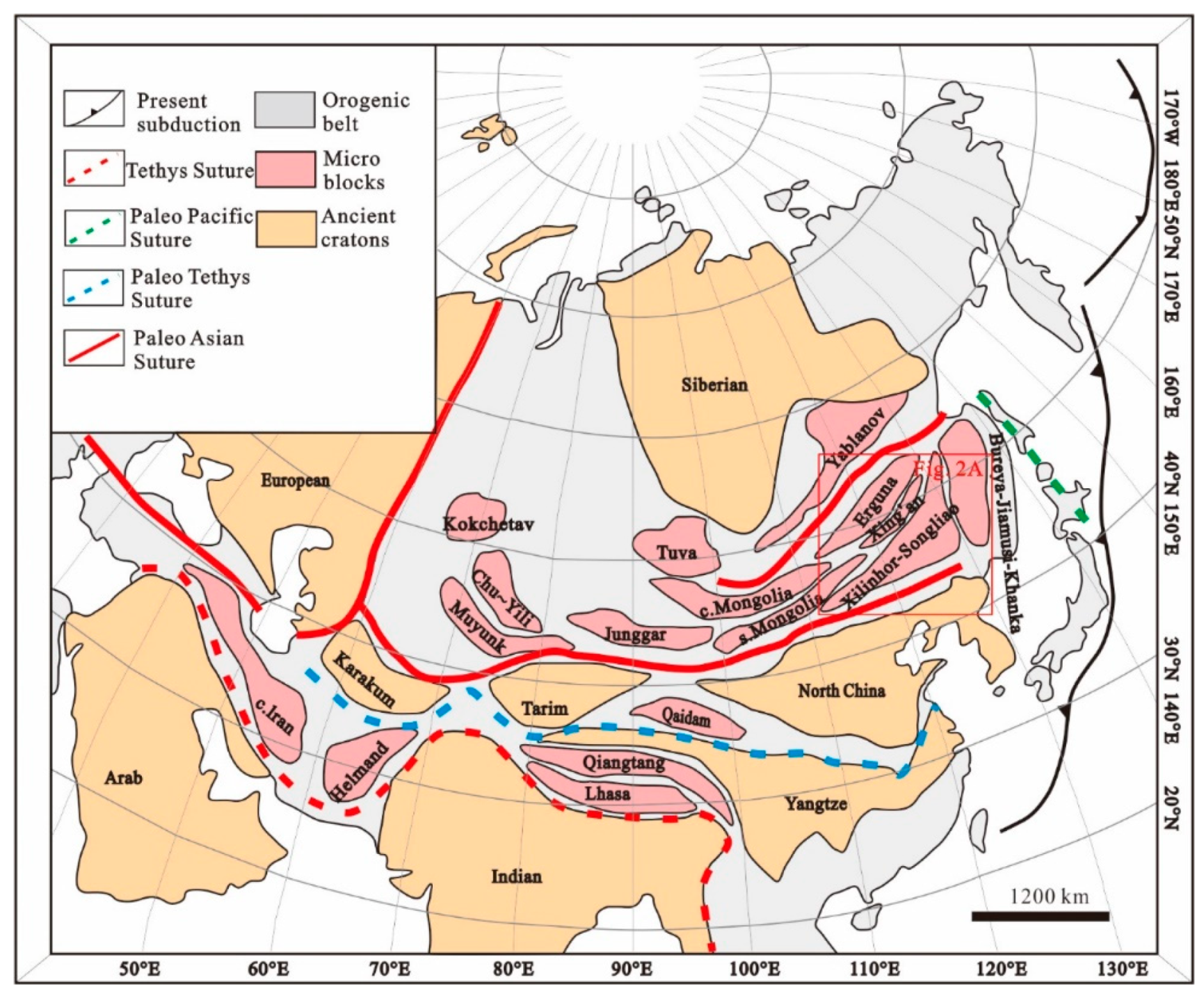
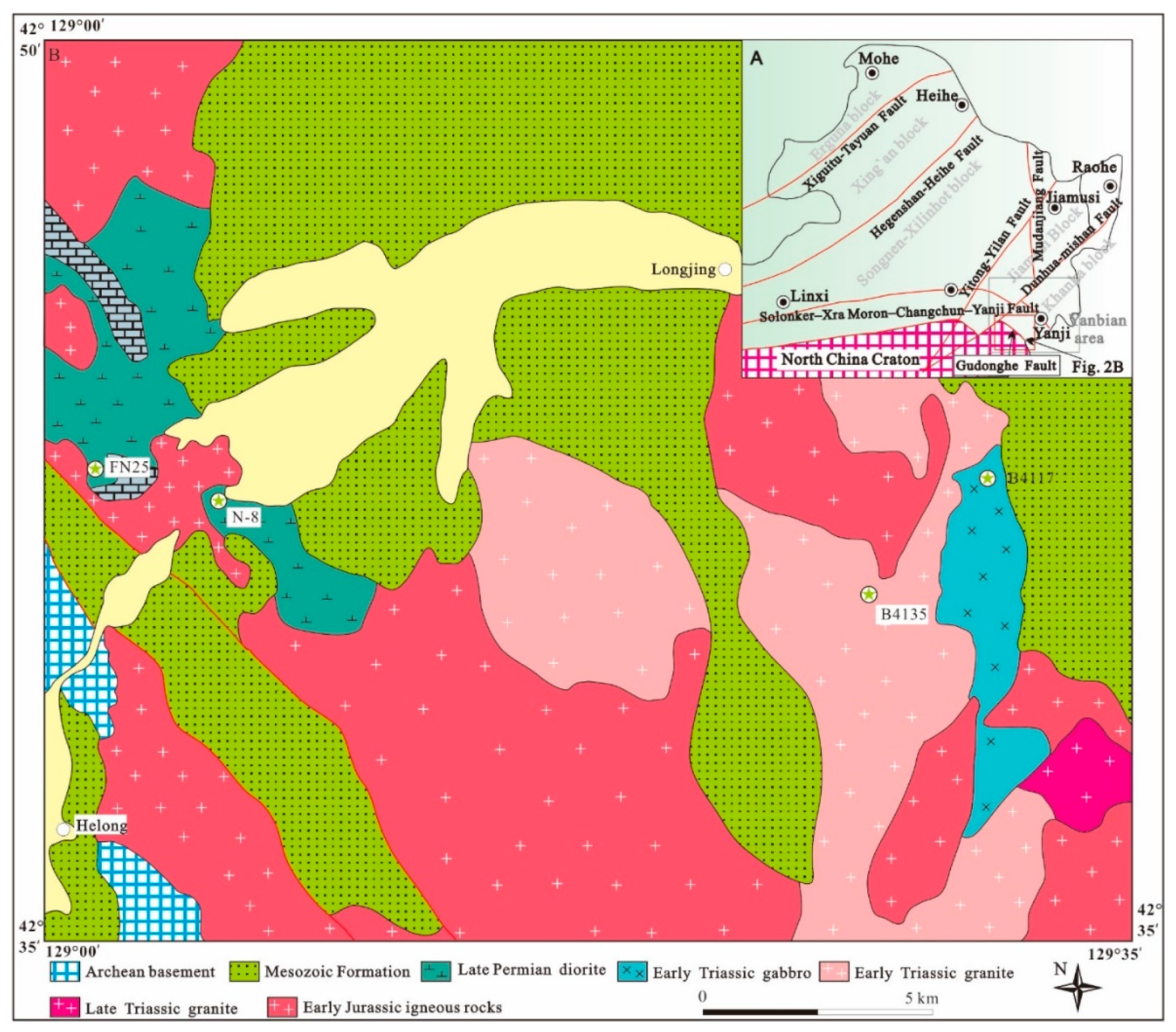
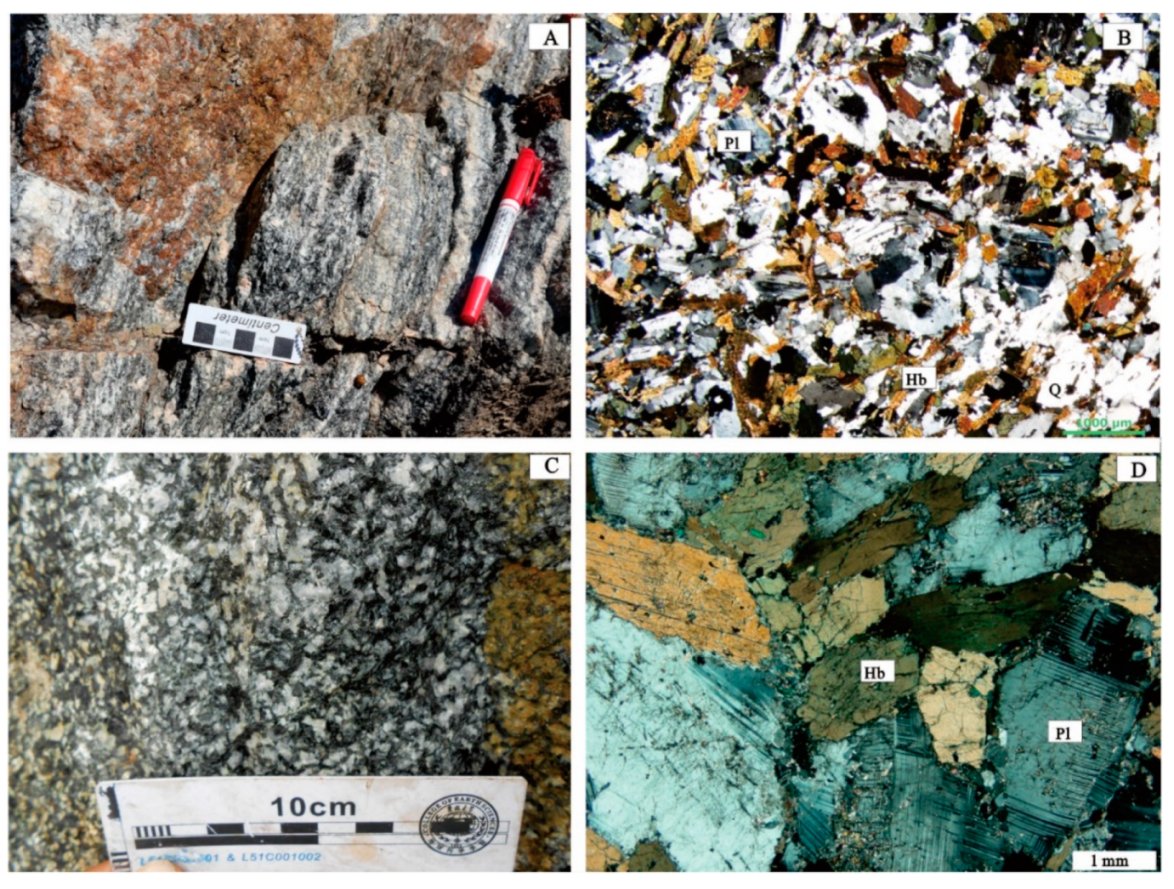
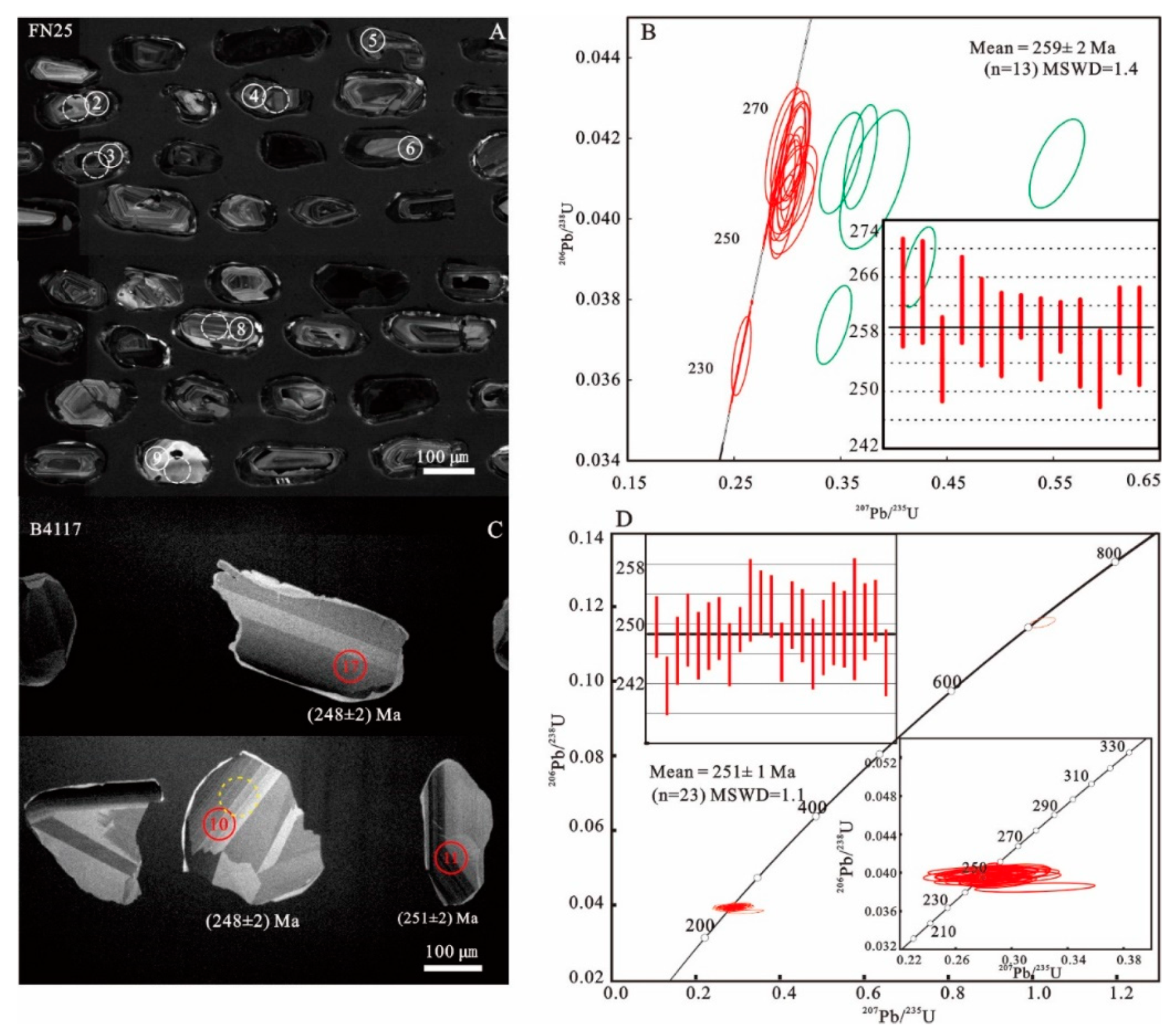
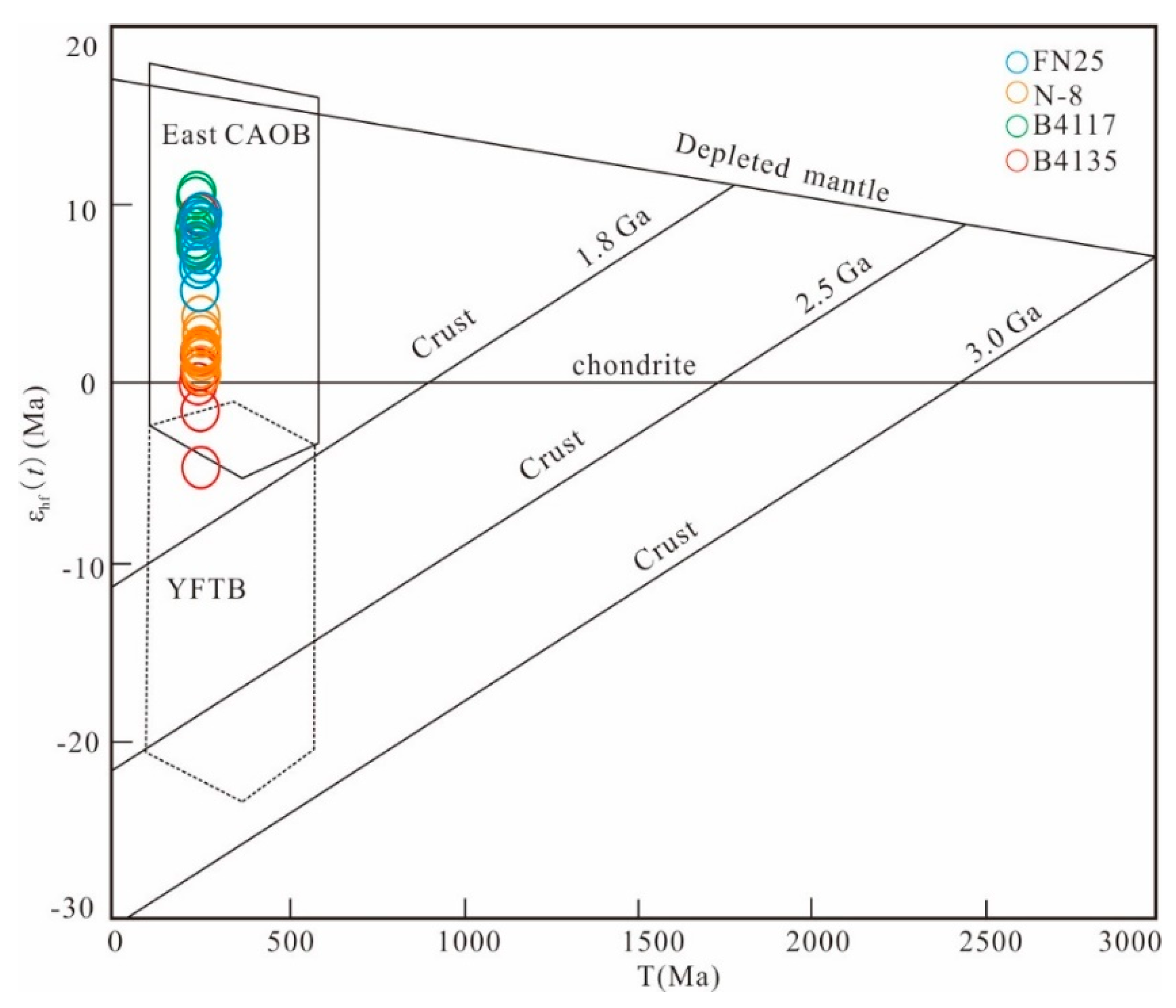
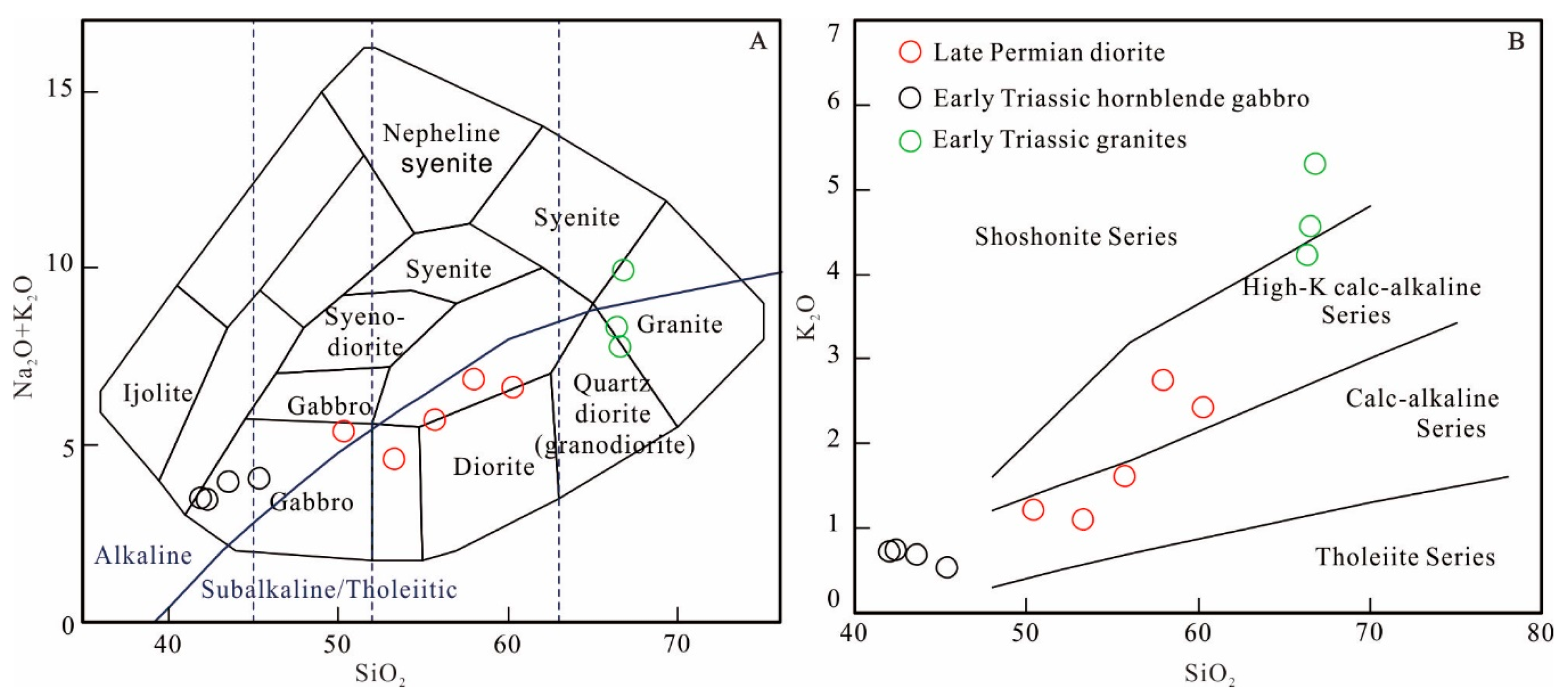
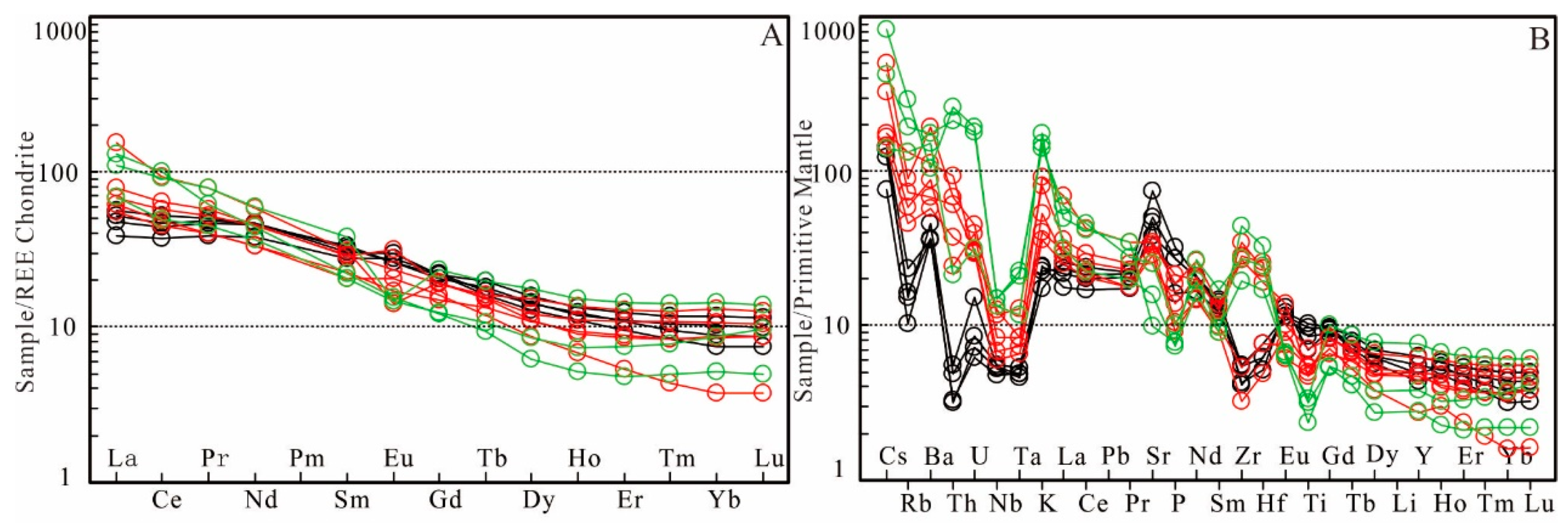
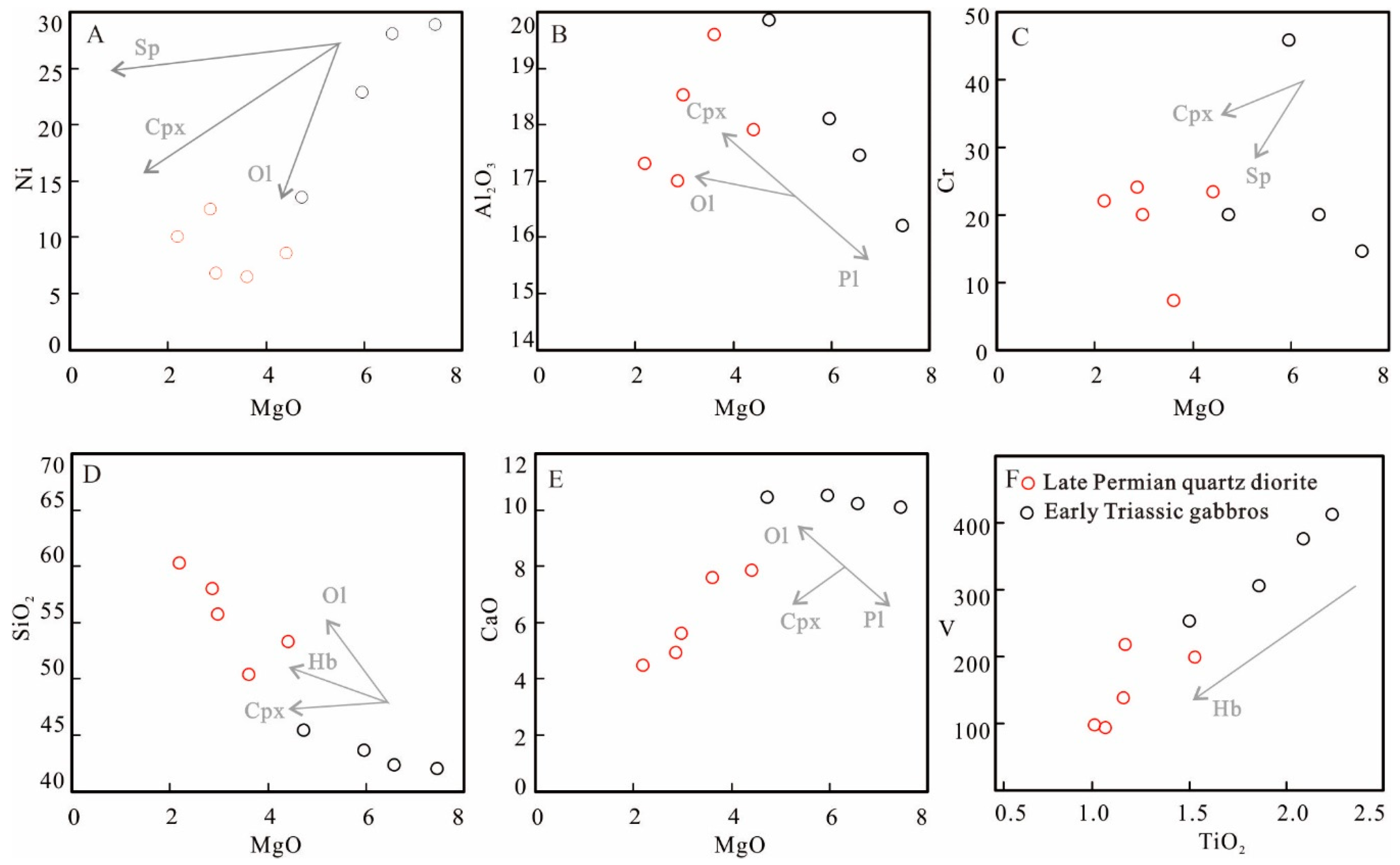
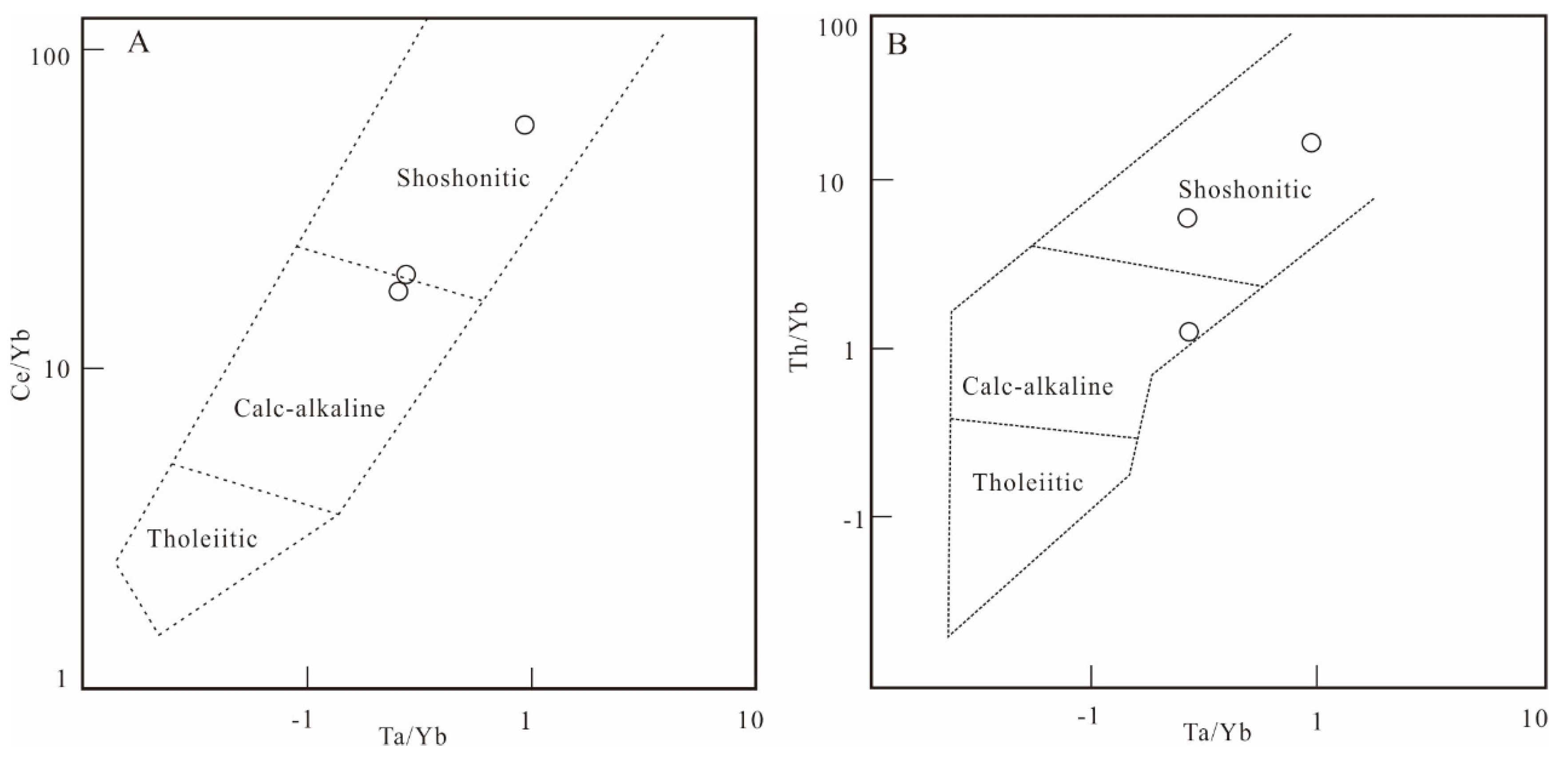
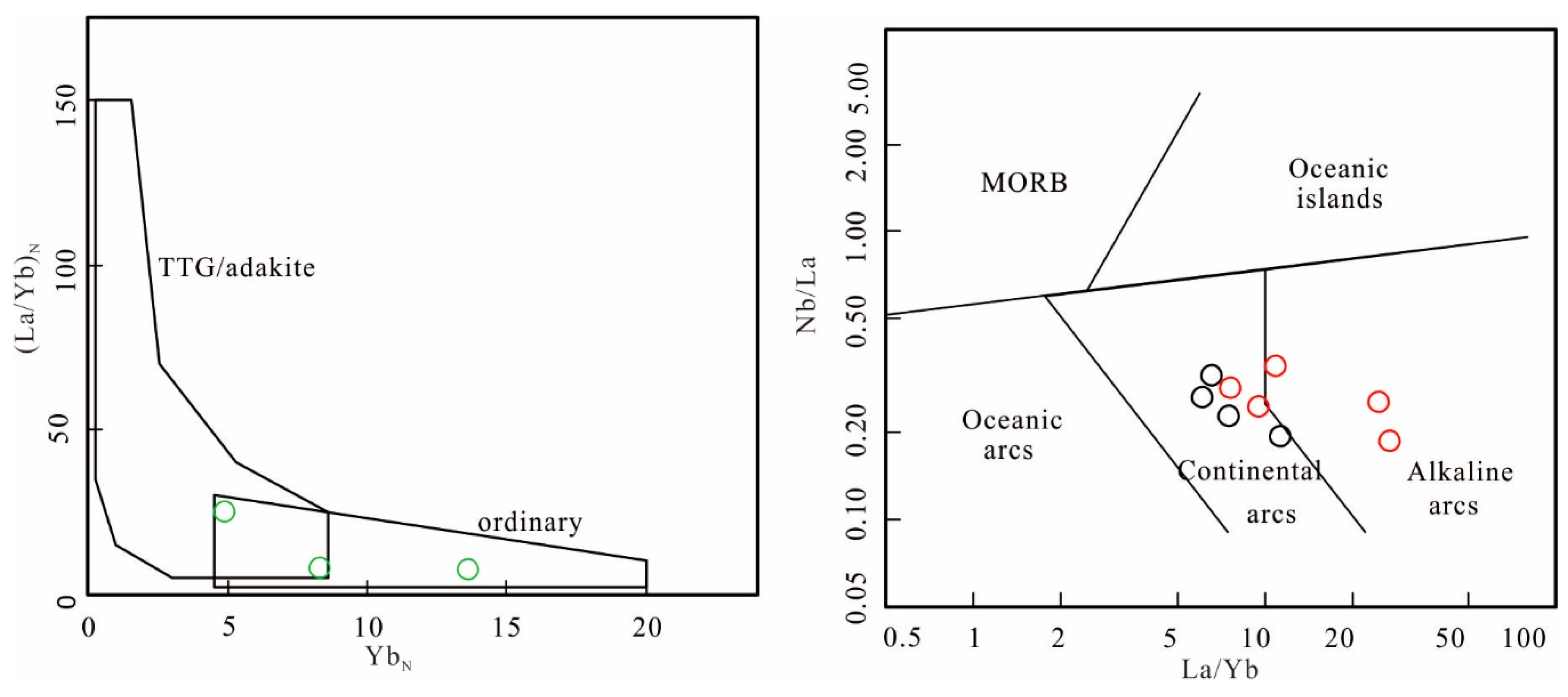
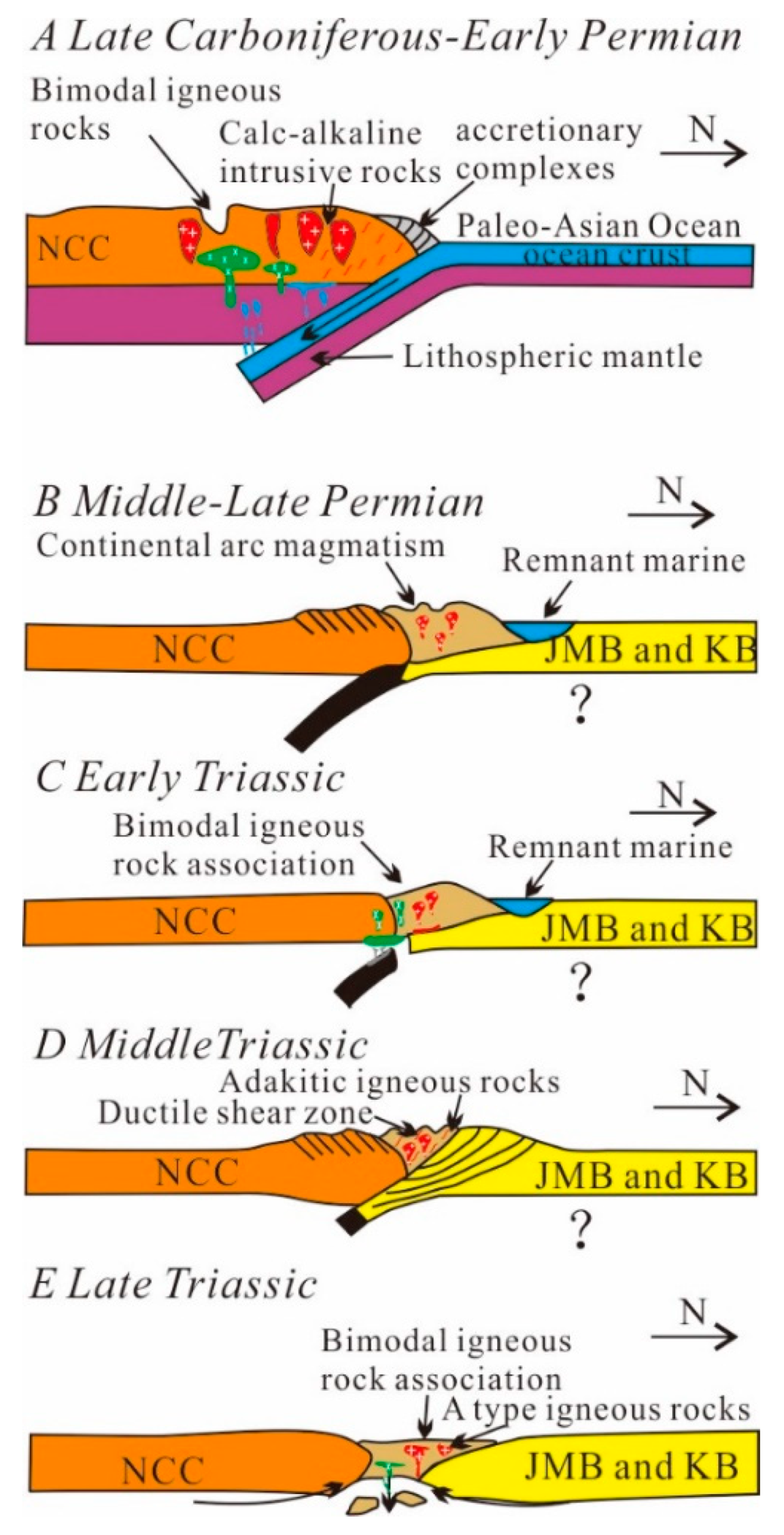

| NO. | Th (×10−6) | U (×10−6) | Th/U | 207Pb/206Pb | 1σ | 207Pb/235U | 1σ | 206Pb/238U | 1σ | 208Pb/232Th | 1σ | 207Pb/235U | 1σ | 206Pb/238U | 1σ |
|---|---|---|---|---|---|---|---|---|---|---|---|---|---|---|---|
| B4117.1 | 419 | 679 | 0.62 | 0.0515 | 0.0010 | 0.2827 | 0.0059 | 0.0398 | 0.0003 | 0.0084 | 0.0003 | 253 | 5 | 252 | 2 |
| B4117.2 | 119 | 218 | 0.54 | 0.0595 | 0.0052 | 0.3161 | 0.0284 | 0.0385 | 0.0003 | 0.0084 | 0.0004 | 279 | 25 | 244 | 2 |
| B4117.3 | 96 | 171 | 0.56 | 0.0514 | 0.0032 | 0.2784 | 0.0174 | 0.0393 | 0.0004 | 0.0092 | 0.0003 | 249 | 16 | 248 | 2 |
| B4117.4 | 94 | 190 | 0.50 | 0.0524 | 0.0028 | 0.2870 | 0.0156 | 0.0397 | 0.0004 | 0.0092 | 0.0003 | 256 | 14 | 251 | 2 |
| B4117.5 | 107 | 199 | 0.54 | 0.0526 | 0.0026 | 0.2857 | 0.0147 | 0.0394 | 0.0004 | 0.0092 | 0.0004 | 255 | 13 | 249 | 2 |
| B4117.6 | 64 | 176 | 0.37 | 0.0527 | 0.0029 | 0.2875 | 0.0161 | 0.0396 | 0.0004 | 0.0080 | 0.0003 | 257 | 14 | 250 | 2 |
| B4117.7 | 111 | 153 | 0.72 | 0.0640 | 0.0013 | 1.0229 | 0.0211 | 0.1159 | 0.0009 | 0.0260 | 0.0009 | 715 | 15 | 707 | 6 |
| B4117.8 | 34 | 97 | 0.35 | 0.0520 | 0.0047 | 0.2850 | 0.0263 | 0.0398 | 0.0003 | 0.0080 | 0.0005 | 255 | 23 | 251 | 2 |
| B4117.9 | 105 | 254 | 0.41 | 0.0521 | 0.0023 | 0.2818 | 0.0127 | 0.0392 | 0.0003 | 0.0105 | 0.0004 | 252 | 11 | 248 | 2 |
| B4117.10 | 83 | 354 | 0.24 | 0.0514 | 0.0015 | 0.2819 | 0.0087 | 0.0397 | 0.0002 | 0.0100 | 0.0004 | 252 | 8 | 251 | 2 |
| B4117.11 | 150 | 608 | 0.25 | 0.0510 | 0.0010 | 0.2839 | 0.0057 | 0.0404 | 0.0004 | 0.0115 | 0.0004 | 254 | 5 | 255 | 3 |
| B4117.12 | 185 | 316 | 0.58 | 0.0513 | 0.0026 | 0.2853 | 0.0151 | 0.0403 | 0.0003 | 0.0125 | 0.0005 | 255 | 14 | 255 | 2 |
| B4117.13 | 33 | 121 | 0.27 | 0.0511 | 0.0054 | 0.2836 | 0.0291 | 0.0402 | 0.0003 | 0.0130 | 0.0008 | 254 | 26 | 254 | 2 |
| B4117.14 | 69 | 127 | 0.54 | 0.0515 | 0.0042 | 0.2786 | 0.0228 | 0.0393 | 0.0003 | 0.0135 | 0.0007 | 250 | 20 | 248 | 2 |
| B4117.15 | 47 | 180 | 0.26 | 0.0511 | 0.0032 | 0.2823 | 0.0236 | 0.0401 | 0.0004 | 0.0152 | 0.0020 | 252 | 21 | 253 | 2 |
| B4117.16 | 39 | 81 | 0.48 | 0.0511 | 0.0046 | 0.2806 | 0.0239 | 0.0398 | 0.0004 | 0.0125 | 0.0008 | 251 | 21 | 252 | 2 |
| B4117.17 | 110 | 176 | 0.62 | 0.0535 | 0.0032 | 0.2894 | 0.0184 | 0.0392 | 0.0004 | 0.0140 | 0.0007 | 258 | 16 | 248 | 2 |
| B4117.18 | 30 | 139 | 0.22 | 0.0548 | 0.0041 | 0.2992 | 0.0235 | 0.0396 | 0.0004 | 0.0120 | 0.0009 | 266 | 21 | 250 | 3 |
| B4117.19 | 5 | 75 | 0.06 | 0.0525 | 0.0034 | 0.2885 | 0.0249 | 0.0399 | 0.0004 | 0.0480 | 0.0099 | 257 | 22 | 252 | 3 |
| B4117.20 | 71 | 232 | 0.31 | 0.0493 | 0.0038 | 0.2700 | 0.0224 | 0.0398 | 0.0004 | 0.0140 | 0.0011 | 243 | 20 | 251 | 3 |
| B4117.21 | 28 | 65 | 0.43 | 0.0541 | 0.0039 | 0.2982 | 0.0191 | 0.0400 | 0.0006 | 0.0190 | 0.0019 | 265 | 17 | 253 | 4 |
| B4117.22 | 33 | 94 | 0.35 | 0.0534 | 0.0041 | 0.2939 | 0.0261 | 0.0399 | 0.0004 | 0.0137 | 0.0008 | 262 | 23 | 252 | 3 |
| B4117.23 | 50 | 116 | 0.43 | 0.0513 | 0.0041 | 0.2841 | 0.0229 | 0.0401 | 0.0003 | 0.0102 | 0.0005 | 254 | 20 | 254 | 2 |
| B4117.24 | 72 | 341 | 0.21 | 0.0542 | 0.0025 | 0.2916 | 0.0146 | 0.0390 | 0.0004 | 0.0135 | 0.0007 | 260 | 13 | 247 | 2 |
| FN25.1 | 144 | 364 | 0.40 | 0.0517 | 0.0012 | 0.2981 | 0.0076 | 0.0418 | 0.0006 | 0.0124 | 0.0004 | 265 | 7 | 264 | 4 |
| FN25.2 | 247 | 468 | 0.53 | 0.0526 | 0.0012 | 0.3032 | 0.0076 | 0.0418 | 0.0006 | 0.0121 | 0.0004 | 269 | 7 | 264 | 4 |
| FN25.3 | 772 | 1394 | 0.55 | 0.0548 | 0.0014 | 0.3041 | 0.0087 | 0.0403 | 0.0005 | 0.0122 | 0.0003 | 270 | 8 | 254 | 3 |
| FN25.4 | 301 | 709 | 0.42 | 0.0532 | 0.0008 | 0.3052 | 0.0050 | 0.0416 | 0.0005 | 0.0116 | 0.0003 | 270 | 4 | 263 | 3 |
| FN25.5 | 705 | 1235 | 0.57 | 0.0539 | 0.0007 | 0.3057 | 0.0049 | 0.0411 | 0.0005 | 0.0119 | 0.0003 | 271 | 4 | 260 | 3 |
| FN25.6 | 687 | 1009 | 0.68 | 0.0536 | 0.0007 | 0.3016 | 0.0045 | 0.0408 | 0.0005 | 0.0115 | 0.0003 | 268 | 4 | 258 | 3 |
| FN25.7 | 387 | 678 | 0.57 | 0.0615 | 0.0011 | 0.3508 | 0.0084 | 0.0414 | 0.0005 | 0.0143 | 0.0005 | 305 | 7 | 261 | 3 |
| FN25.8 | 381 | 813 | 0.47 | 0.0536 | 0.0007 | 0.3085 | 0.0048 | 0.0417 | 0.0005 | 0.0117 | 0.0004 | 273 | 4 | 263 | 3 |
| FN25.9 | 150 | 297 | 0.51 | 0.0544 | 0.0016 | 0.3054 | 0.0092 | 0.0407 | 0.0004 | 0.0119 | 0.0004 | 271 | 8 | 257 | 3 |
| FN25.10 | 601 | 989 | 0.61 | 0.0644 | 0.0009 | 0.3689 | 0.0065 | 0.0415 | 0.0005 | 0.0127 | 0.0004 | 319 | 6 | 262 | 3 |
| FN25.11 | 214 | 490 | 0.44 | 0.0532 | 0.0010 | 0.3049 | 0.0068 | 0.0416 | 0.0005 | 0.0114 | 0.0003 | 270 | 6 | 263 | 3 |
| FN25.12 | 767 | 1381 | 0.56 | 0.0676 | 0.0016 | 0.3820 | 0.0134 | 0.0410 | 0.0007 | 0.0142 | 0.0006 | 329 | 12 | 259 | 4 |
| FN25.13 | 551 | 1010 | 0.55 | 0.0539 | 0.0010 | 0.3017 | 0.0064 | 0.0406 | 0.0005 | 0.0108 | 0.0003 | 268 | 6 | 257 | 3 |
| FN25.14 | 564 | 1059 | 0.53 | 0.0970 | 0.0016 | 0.5534 | 0.0105 | 0.0414 | 0.0005 | 0.0194 | 0.0006 | 447 | 9 | 261 | 3 |
| FN25.15 | 840 | 1365 | 0.62 | 0.0536 | 0.0008 | 0.2960 | 0.0047 | 0.0401 | 0.0004 | 0.0099 | 0.0003 | 263 | 4 | 253 | 3 |
| FN25.16 | 636 | 1226 | 0.52 | 0.0509 | 0.0006 | 0.2570 | 0.0037 | 0.0366 | 0.0004 | 0.0094 | 0.0004 | 232 | 3 | 232 | 3 |
| FN25.17 | 359 | 1134 | 0.32 | 0.0667 | 0.0012 | 0.3439 | 0.0067 | 0.0374 | 0.0004 | 0.0107 | 0.0004 | 300 | 6 | 237 | 3 |
| FN25.18 | 347 | 682 | 0.51 | 0.0535 | 0.0007 | 0.3019 | 0.0046 | 0.0409 | 0.0005 | 0.0098 | 0.0003 | 268 | 4 | 259 | 3 |
| FN25.19 | 1645 | 1704 | 0.97 | 0.0792 | 0.0011 | 0.4236 | 0.0064 | 0.0388 | 0.0004 | 0.0094 | 0.0002 | 359 | 5 | 245 | 3 |
| FN25.20 | 75 | 1186 | 0.06 | 0.0525 | 0.0007 | 0.2953 | 0.0050 | 0.0408 | 0.0005 | 0.0092 | 0.0002 | 263 | 4 | 258 | 3 |
| No. | Age (Ma) | 176Yb/177Hf | 176Lu/177Hf | 176Hf/177Hf | 176Hf/177Hfi | eHf(0) | eHf(t) | TDM (Ma) | TDMC (Ma) | fLu/Hf | |||
|---|---|---|---|---|---|---|---|---|---|---|---|---|---|
| B4117.1 | 252 | 0.0348 | 0.0001 | 0.0014 | 0.0000 | 0.282836 | 0.000023 | 0.282830 | 2.3 | 7.6 | 596 | 1022 | −0.96 |
| B4117.2 | 244 | 0.0118 | 0.0001 | 0.0005 | 0.0000 | 0.282869 | 0.000021 | 0.282867 | 3.4 | 8.7 | 536 | 914 | −0.99 |
| B4117.3 | 248 | 0.0139 | 0.0001 | 0.0005 | 0.0000 | 0.282854 | 0.000016 | 0.282851 | 2.9 | 8.2 | 559 | 958 | −0.98 |
| B4117.4 | 251 | 0.0142 | 0.0001 | 0.0005 | 0.0000 | 0.282922 | 0.000017 | 0.282919 | 5.3 | 10.7 | 463 | 735 | −0.98 |
| B4117.5 | 249 | 0.0118 | 0.0001 | 0.0004 | 0.0000 | 0.282838 | 0.000016 | 0.282836 | 2.3 | 7.7 | 579 | 1006 | −0.99 |
| B4117.6 | 250 | 0.0112 | 0.0000 | 0.0005 | 0.0000 | 0.282849 | 0.000020 | 0.282847 | 2.7 | 8.2 | 564 | 968 | −0.99 |
| B4117.8 | 251 | 0.0070 | 0.0001 | 0.0003 | 0.0000 | 0.282839 | 0.000018 | 0.282838 | 2.4 | 7.9 | 575 | 996 | −0.99 |
| B4117.9 | 248 | 0.0148 | 0.0001 | 0.0006 | 0.0000 | 0.282916 | 0.000018 | 0.282913 | 5.1 | 10.4 | 472 | 760 | −0.98 |
| B4117.10 | 251 | 0.0116 | 0.0002 | 0.0005 | 0.0000 | 0.282882 | 0.000018 | 0.282879 | 3.9 | 9.3 | 519 | 864 | −0.98 |
| B4135.2 | 252 | 0.0177 | 0.0005 | 0.0008 | 0.0000 | 0.282639 | 0.000019 | 0.282635 | −4.7 | 0.7 | 865 | 1644 | −0.97 |
| B4135.3 | 253 | 0.0086 | 0.0001 | 0.0004 | 0.0000 | 0.282628 | 0.000017 | 0.282626 | −5.1 | 0.4 | 870 | 1670 | −0.99 |
| B4135.4 | 254 | 0.0230 | 0.0003 | 0.0010 | 0.0000 | 0.282630 | 0.000017 | 0.282626 | −5.0 | 0.4 | 881 | 1671 | −0.97 |
| B4135.6 | 253 | 0.0170 | 0.0001 | 0.0008 | 0.0000 | 0.282661 | 0.000015 | 0.282658 | −3.9 | 1.5 | 833 | 1571 | −0.98 |
| B4135.7 | 247 | 0.0116 | 0.0001 | 0.0006 | 0.0000 | 0.282618 | 0.000013 | 0.282615 | −5.5 | −0.1 | 889 | 1713 | −0.98 |
| B4135.8 | 252 | 0.0122 | 0.0003 | 0.0006 | 0.0000 | 0.282661 | 0.000012 | 0.282659 | −3.9 | 1.5 | 828 | 1568 | −0.98 |
| B4135.9 | 253 | 0.0210 | 0.0003 | 0.0009 | 0.0000 | 0.282573 | 0.000014 | 0.282569 | −7.0 | −1.6 | 959 | 1854 | −0.97 |
| B4135.10 | 251 | 0.0087 | 0.0002 | 0.0004 | 0.0000 | 0.282885 | 0.000015 | 0.282883 | 4.0 | 9.4 | 513 | 852 | −0.99 |
| B4135.12 | 255 | 0.0525 | 0.0006 | 0.0019 | 0.0000 | 0.282488 | 0.000016 | 0.282479 | −10.0 | −4.8 | 1108 | 2136 | −0.94 |
| B4135.13 | 253 | 0.0060 | 0.0000 | 0.0003 | 0.0000 | 0.282668 | 0.000015 | 0.282666 | −3.7 | 1.8 | 813 | 1543 | −0.99 |
| N8.1 | 257 | 0.0150 | 0.0008 | 0.0006 | 0.0000 | 0.282669 | 0.000017 | 0.282666 | −3.6 | 1.9 | 819 | 1539 | −0.98 |
| N8.2 | 259 | 0.0133 | 0.0006 | 0.0006 | 0.0000 | 0.282697 | 0.000017 | 0.282694 | −2.6 | 2.9 | 778 | 1445 | −0.98 |
| N8.3 | 259 | 0.0281 | 0.0009 | 0.0010 | 0.0000 | 0.282652 | 0.000021 | 0.282647 | −4.2 | 1.3 | 851 | 1596 | −0.97 |
| N8.5 | 259 | 0.0167 | 0.0002 | 0.0007 | 0.0000 | 0.282656 | 0.000015 | 0.282653 | −4.1 | 1.5 | 838 | 1578 | −0.98 |
| N8.6 | 257 | 0.0314 | 0.0011 | 0.0012 | 0.0000 | 0.282644 | 0.000019 | 0.282638 | −4.5 | 0.9 | 867 | 1628 | −0.96 |
| N8.7 | 257 | 0.0196 | 0.0004 | 0.0007 | 0.0000 | 0.282720 | 0.000018 | 0.282716 | −1.8 | 3.7 | 749 | 1377 | −0.98 |
| N8.8 | 259 | 0.0227 | 0.0002 | 0.0009 | 0.0000 | 0.282672 | 0.000016 | 0.282668 | −3.5 | 2.0 | 819 | 1530 | −0.97 |
| N8.10 | 258 | 0.0228 | 0.0003 | 0.0009 | 0.0000 | 0.282669 | 0.000013 | 0.282665 | −3.6 | 1.9 | 825 | 1541 | −0.97 |
| N8.19 | 259 | 0.0260 | 0.0007 | 0.0010 | 0.0000 | 0.282629 | 0.000020 | 0.282624 | −5.1 | 0.5 | 882 | 1669 | −0.97 |
| N8.22 | 257 | 0.0258 | 0.0008 | 0.0010 | 0.0000 | 0.282665 | 0.000017 | 0.282660 | −3.8 | 1.7 | 832 | 1558 | −0.97 |
| N8.23 | 259 | 0.0232 | 0.0003 | 0.0010 | 0.0000 | 0.282690 | 0.000020 | 0.282685 | −2.9 | 2.6 | 796 | 1474 | −0.97 |
| FN25.21 | 258 | 0.0665 | 0.0032 | 0.0020 | 0.0001 | 0.282867 | 0.000038 | 0.282858 | 3.4 | 8.7 | 561 | 924 | −0.94 |
| FN25.1 | 264 | 0.0186 | 0.0004 | 0.0005 | 0.0000 | 0.282880 | 0.000032 | 0.282877 | 3.8 | 9.5 | 521 | 853 | −0.99 |
| FN25.2 | 264 | 0.0372 | 0.0042 | 0.0011 | 0.0001 | 0.282882 | 0.000032 | 0.282876 | 3.9 | 9.5 | 526 | 856 | −0.97 |
| FN25.3 | 254 | 0.0598 | 0.0012 | 0.0018 | 0.0000 | 0.282807 | 0.000029 | 0.282799 | 1.2 | 6.5 | 645 | 1118 | −0.95 |
| FN25.4 | 263 | 0.0246 | 0.0011 | 0.0008 | 0.0000 | 0.282804 | 0.000026 | 0.282801 | 1.1 | 6.8 | 631 | 1100 | −0.98 |
| FN25.8 | 263 | 0.0378 | 0.0003 | 0.0011 | 0.0000 | 0.282869 | 0.000024 | 0.282864 | 3.4 | 9.0 | 545 | 898 | −0.97 |
| FN25.9 | 257 | 0.0394 | 0.0010 | 0.0011 | 0.0000 | 0.282765 | 0.000027 | 0.282760 | −0.2 | 5.2 | 691 | 1237 | −0.97 |
| FN25.13 | 257 | 0.0378 | 0.0004 | 0.0012 | 0.0000 | 0.282840 | 0.000027 | 0.282834 | 2.4 | 7.8 | 588 | 1002 | −0.96 |
| FN25.15 | 253 | 0.0550 | 0.0005 | 0.0016 | 0.0000 | 0.282881 | 0.000025 | 0.282873 | 3.9 | 9.1 | 536 | 881 | −0.95 |
| FN25.19 | 259 | 0.0310 | 0.0012 | 0.0009 | 0.0000 | 0.282821 | 0.000024 | 0.282816 | 1.7 | 7.3 | 610 | 1055 | −0.97 |
| Sample | B4117-1 | B4117-2 | Yh59-2 | Yh59-3 | Dh034 | Dh041 | 1245-1 | N-8 | B4396-1 | 4119-1 | YH34 | 4134-1 |
|---|---|---|---|---|---|---|---|---|---|---|---|---|
| SiO2 | 42 | 43.6 | 45.42 | 42.36 | 60.3 | 50.4 | 53.3 | 58.0 | 55.7 | 66.8 | 66.4 | 66.6 |
| Al2O3 | 16.2 | 18.1 | 19.86 | 17.46 | 17.3 | 19.6 | 17.9 | 17.0 | 18.5 | 16.3 | 15.8 | 14.5 |
| Fe2O3 | 6.92 | 5.41 | 11.53 | 14.57 | 2.33 | 3.86 | 3.62 | 0.99 | 2.30 | 1.10 | 2.19 | 1.63 |
| FeO | 8.6 | 7.7 | 7.26 | 9.67 | 3.82 | 6.05 | 5.43 | 6.41 | 5.12 | 1.85 | 1.70 | 2.93 |
| CaO | 10.1 | 10.5 | 10.44 | 10.23 | 4.47 | 7.58 | 7.85 | 4.94 | 5.60 | 1.64 | 2.38 | 3.01 |
| MgO | 7.46 | 5.96 | 4.73 | 6.57 | 2.20 | 3.62 | 4.42 | 2.86 | 2.98 | 0.81 | 0.95 | 1.65 |
| K2O | 0.72 | 0.68 | 0.52 | 0.73 | 2.41 | 1.21 | 1.09 | 2.74 | 1.61 | 5.30 | 4.22 | 4.56 |
| Na2O | 2.74 | 3.24 | 3.51 | 2.71 | 4.20 | 4.15 | 3.5 | 4.11 | 4.08 | 4.62 | 4.08 | 3.18 |
| TiO2 | 2.09 | 1.86 | 1.5 | 2.24 | 1.01 | 1.53 | 1.17 | 1.07 | 1.16 | 0.51 | 0.68 | 0.73 |
| P2O5 | 0.59 | 0.59 | 0.7 | 0.35 | 0.30 | 0.46 | 0.20 | 0.41 | 0.23 | 0.16 | 0.22 | 0.17 |
| MnO | 0.18 | 0.18 | 0.14 | 0.18 | 0.13 | 0.13 | 0.16 | 0.11 | 0.10 | 0.10 | 0.06 | 0.08 |
| LOI | 1.38 | 1.13 | 1.12 | 2.05 | 0.91 | 0.60 | 0.65 | 0.47 | 1.19 | 0.44 | 0.90 | 0.53 |
| Mg# | 47 | 46 | 45 | 47 | 50.66 | 51.61 | 59.2 | 44.3 | 50.92 | 43.84 | 49.90 | 50.1 |
| A/CNK | 0.685 | 0.719 | 0.784 | 0.732 | 0.98 | 0.89 | 0.84 | 0.91 | 0.99 | 1.00 | 1.01 | 0.93 |
| Cr | 14.6 | 45.9 | 20 | 20 | 22 | 7.27 | 23.3 | 24.10 | 20 | 13.1 | 7.7 | 20.5 |
| Ni | 28.9 | 22.9 | 13.5 | 28.1 | 10.0 | 6.47 | 8.56 | 12.5 | 6.8 | 5.23 | 4.21 | 10 |
| Co | 54.2 | 42.5 | 27.1 | 45.4 | 12.1 | 23.5 | 26.5 | 15.0 | 20.3 | 4.48 | 5.06 | 9.64 |
| Rb | 9.75 | 10.5 | 6.5 | 14.8 | 56.7 | 37.0 | 28.9 | 84.8 | 46.7 | 84.7 | 124 | 186 |
| Cs | 1.1 | 0.98 | 0.6 | 1.15 | 3.96 | 1.31 | 1.15 | 1.40 | 2.6 | 1.11 | 3.36 | 6.57 |
| Sr | 809 | 1060 | 1585 | 987 | 536 | 710 | 603 | 733 | 677 | 331 | 534 | 208 |
| Ba | 320 | 255 | 250 | 250 | 1350 | 621 | 405 | 789 | 471 | 1070 | 1240 | 729 |
| V | 376 | 306 | 253 | 412 | 97.1 | 198 | 218 | 92.7 | 137 | 35.7 | 42.9 | 81.8 |
| Sc | 29.7 | 24.3 | 12.6 | 24.7 | 15.2 | 19.8 | 22.7 | 8.25 | 6.7 | 6.69 | 3.15 | 11.4 |
| Nb | 3.93 | 3.71 | 3.4 | 3.8 | 8.35 | 5.95 | 4.27 | 8.98 | 4.9 | 9.56 | 10.6 | 10.6 |
| Ta | 0.22 | 0.19 | 0.2 | 0.2 | 0.53 | 0.34 | 0.27 | 0.34 | 0.3 | 0.48 | 0.93 | 0.85 |
| Zr | 62.4 | 46.4 | 48 | 61 | 300 | 389 | 59.5 | 318 | 36 | 499 | 217 | 307 |
| Hf | 2.37 | 1.9 | 1.6 | 1.9 | 5.93 | 7.21 | 2.37 | 7.97 | 1.5 | 10.2 | 5.22 | 7.57 |
| U | 0.18 | 0.15 | 0.13 | 0.32 | 0.95 | 0.83 | 0.63 | 0.61 | 0.64 | 0.66 | 3.76 | 4.05 |
| Th | 0.41 | 0.27 | 0.28 | 0.47 | 5.81 | 2.08 | 3.20 | 7.97 | 5.19 | 1.82 | 18.1 | 22.2 |
| La | 14.9 | 16.2 | 17.5 | 12.1 | 24.6 | 20.9 | 17.3 | 47.9 | 19.3 | 21.6 | 40.6 | 34.2 |
| Ce | 35.8 | 37.8 | 42 | 30.3 | 52.3 | 46.0 | 36.7 | 76.0 | 39 | 39.7 | 80.7 | 74.3 |
| Pr | 5.71 | 5.94 | 6.15 | 4.77 | 7 | 6.39 | 4.87 | 9.54 | 4.9 | 5.5 | 7.58 | 9.63 |
| Nd | 27.6 | 27.9 | 28.2 | 22.8 | 27.6 | 26.9 | 20.2 | 35.3 | 20 | 21.9 | 26.3 | 35.9 |
| Sm | 6.53 | 6.27 | 5.95 | 5.43 | 5.65 | 5.75 | 4.40 | 6.08 | 4.01 | 4.01 | 4.31 | 7.49 |
| Eu | 1.93 | 1.94 | 2.21 | 2.03 | 2.33 | 1.71 | 1.26 | 1.03 | 1.52 | 1.07 | 1.13 | 1.08 |
| Gd | 5.67 | 5.32 | 5.59 | 5.78 | 4.96 | 4.92 | 3.90 | 5.03 | 4.18 | 3.23 | 3.17 | 6.04 |
| Tb | 0.94 | 0.86 | 0.76 | 0.81 | 0.74 | 0.77 | 0.63 | 0.72 | 0.57 | 0.51 | 0.44 | 0.94 |
| Dy | 5.13 | 4.62 | 4.16 | 4.59 | 3.89 | 4.88 | 3.52 | 3.57 | 2.79 | 2.76 | 2.01 | 5.68 |
| Ho | 0.95 | 0.85 | 0.79 | 0.89 | 0.79 | 0.98 | 0.67 | 0.65 | 0.49 | 0.53 | 0.37 | 1.1 |
| Er | 2.58 | 2.33 | 2.02 | 2.27 | 2.28 | 2.72 | 1.85 | 1.79 | 1.13 | 1.57 | 1 | 3.01 |
| Tm | 0.38 | 0.34 | 0.27 | 0.31 | 0.35 | 0.41 | 0.27 | 0.27 | 0.14 | 0.25 | 0.16 | 0.46 |
| Yb | 2.44 | 2.15 | 1.55 | 1.84 | 2.25 | 2.72 | 1.81 | 1.78 | 0.78 | 1.83 | 1.08 | 3 |
| Lu | 0.37 | 0.32 | 0.24 | 0.28 | 0.34 | 0.41 | 0.28 | 0.28 | 0.12 | 0.31 | 0.16 | 0.45 |
| Y | 28.6 | 25.3 | 19.7 | 22.1 | 22.5 | 28.3 | 21.3 | 22.6 | 12.4 | 17.5 | 12.6 | 34.7 |
| ∑REE | 110.93 | 112.84 | 117.39 | 94.2 | 135.08 | 125.46 | 97.66 | 189.94 | 98.93 | 104.77 | 169.01 | 183.28 |
| Nb/Ta | 17.86 | 19.53 | 17.00 | 19.00 | 15.75 | 17.50 | 15.81 | 26.41 | 16.33 | 19.92 | 11.40 | 12.47 |
| Zr/Hf | 26.33 | 24.42 | 30.00 | 32.11 | 50.59 | 53.95 | 25.11 | 39.90 | 24.00 | 48.92 | 41.57 | 40.55 |
| Ba/Rb | 32.82 | 24.29 | 38.46 | 16.89 | 23.81 | 16.78 | 14.01 | 9.30 | 10.09 | 12.63 | 10.00 | 3.92 |
| (La/Yb)N | 4 | 5 | 8 | 4 | 7.37 | 5.18 | 6.44 | 18.14 | 16.68 | 7.96 | 25.34 | 7.69 |
| δEu | 0.97 | 1.03 | 1.17 | 1.11 | 1.35 | 0.98 | 0.93 | 0.57 | 1.14 | 0.91 | 0.93 | 0.49 |
| Sample | t(Ma) | 87Rb/86Sr | 87Sr/86Sr | 2σ(×10−6) | 147Sm/144Nd | 143Nd/144Nd | 2σ(×10−6) | Isr | εNd(t) | TDM1 | TDM2 | fSm/Nd |
|---|---|---|---|---|---|---|---|---|---|---|---|---|
| B4117 | 251 | 0.0349 | 0.70511 | 3 | 0.1513 | 0.51274 | 4 | 0.70499 | 3.4 | 1005 | 743 | −0.23 |
| B3164-1 | 251 | 1.5093 | 0.70915 | 3 | 0.1265 | 0.512561 | 8 | 0.70376 | 0.7 | 1032 | 963 | −0.36 |
© 2020 by the authors. Licensee MDPI, Basel, Switzerland. This article is an open access article distributed under the terms and conditions of the Creative Commons Attribution (CC BY) license (http://creativecommons.org/licenses/by/4.0/).
Share and Cite
Zhang, C.; Neubauer, F.; Liu, Z.-H.; Cui, F.-H.; Guan, Q.-B. Final-Stage Magmatic Record of Paleo-Asian Oceanic Subduction? Insights from Late Permian to Early Triassic Intrusive Rocks in the Yanbian Area, Easternmost Central Asian Orogenic Belt. Minerals 2020, 10, 799. https://doi.org/10.3390/min10090799
Zhang C, Neubauer F, Liu Z-H, Cui F-H, Guan Q-B. Final-Stage Magmatic Record of Paleo-Asian Oceanic Subduction? Insights from Late Permian to Early Triassic Intrusive Rocks in the Yanbian Area, Easternmost Central Asian Orogenic Belt. Minerals. 2020; 10(9):799. https://doi.org/10.3390/min10090799
Chicago/Turabian StyleZhang, Chao, Franz Neubauer, Zheng-Hong Liu, Fang-Hua Cui, and Qing-Bin Guan. 2020. "Final-Stage Magmatic Record of Paleo-Asian Oceanic Subduction? Insights from Late Permian to Early Triassic Intrusive Rocks in the Yanbian Area, Easternmost Central Asian Orogenic Belt" Minerals 10, no. 9: 799. https://doi.org/10.3390/min10090799
APA StyleZhang, C., Neubauer, F., Liu, Z.-H., Cui, F.-H., & Guan, Q.-B. (2020). Final-Stage Magmatic Record of Paleo-Asian Oceanic Subduction? Insights from Late Permian to Early Triassic Intrusive Rocks in the Yanbian Area, Easternmost Central Asian Orogenic Belt. Minerals, 10(9), 799. https://doi.org/10.3390/min10090799






